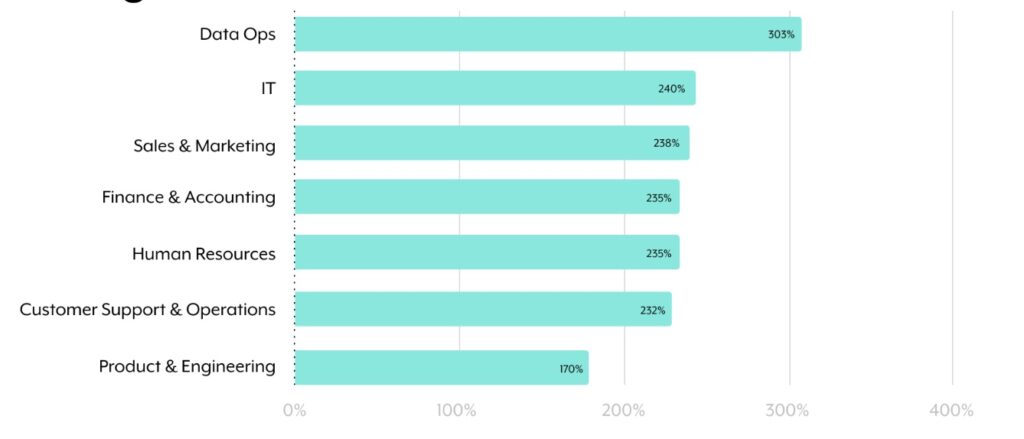- 7 Incoming Human Resource Changes (and How to Prep for Them) - July 25, 2023
There’s been a technological transformation for the past two decades, and it’s accelerated in recent years. We’ve seen a shift towards remote work — as many as 31% of employers now allow it. And several organizations are introducing automated systems for payroll and admin. These human resource changes require a new way of thinking.
In this article, we’ll talk about some upcoming shifts and discuss ways you can prepare and maintain an effective organization.
Human Resource Changes – #1: Greater Automation

Many co.s look to automation as a solution, and it is already having a huge impact on HR across various sectors. There are multiple ways automation benefits your business.
One of the biggest changes is using workflow automation to do regular HR tasks. This saves time on admin work, so HR teams can do more important things that help the company grow. With the right software, you can automate:
- Updating timesheets
- Payroll management
- Performance management
- Paid & sick leave
- Writing job descriptions
Aside from workflows, you can benefit from other forms of automation. Hiring and onboarding is a long drawn-out process, but automation software can handle key parts of both tasks. This reduces the time it takes and means you’ll have new employees in place faster. The sooner they’re employed, the sooner they can settle into their role and become an effective member of the team.
How can HR prepare for this change?
Reassure employees
Employees might worry that machines will replace them. So, tell them they’re important team members and not to worry. Also, explain how automation can help them do more exciting and satisfying tasks.
Ensure solid leadership
Make sure everyone in the HR team knows how to use the new systems. If the leaders understand, others will be motivated to learn too. So, leaders should be ready to answer any questions from the rest of the staff.
Gradual automation
It’s a good idea to go slow when adding automation. If you change everything at once, it can be stressful and make staff feel too much pressure. So, it’s better to add automation to one thing at a time. This way, it’s easier for everyone to adjust.
Human Resource Changes – #2: Find ways to engage remote employees
The transition to a more remote workforce has brought lots of benefits. Virtual employees are up to 35% to 40% more productive than those working in the office. But having remote employees also brings some challenges for HR. Perhaps the biggest is the ability to keep employees engaged.
In a regular office, people talk and work together every day, feeling like part of a big team. But when working from home, some might feel alone. Many companies noticed that this isolation affects mental health.
A big HR change is finding ways to connect with remote employees. They still need to understand the company’s goals and feel involved. They should feel a sense of belonging, not just another cog in the machine, but actively helping their organization achieve success.
How can HR prepare for this change?
Make use of virtual conferencing
Use video meetings instead of just talking on the phone. When you see your coworkers and where they work, you feel more connected. Video calls can be used for fun things too, like watching movies together or having a drink with the team. You can also use it for having an office party online.
Maintain solid communication
People feel more connected when they can easily talk to their team. Use messaging apps for group chats so they can ask for help. You can also have a separate chat for casual talk, like birthday wishes and personal news.
Check-in regularly
Remote workers might think their opinions don’t matter. But leaders can fix this by checking in often and asking for feedback. So, if there are ways to improve processes or if someone is unhappy with a project, take the time to listen and make changes. This way, remote workers can feel valued when their feedback is heard and acted upon.
Human Resource Changes – #3: A new focus on diversity and inclusion
People are talking a lot about diversity and including everyone these days. The Black Lives Matter movement made companies look inside, and they found many problems. These included a lack of diversity in the workforce and an exclusionary approach to hiring people from underrepresented backgrounds.
If it hasn’t already, your company should make some of the following human resource changes:
- Diversify the hiring process.
- Ensuring people from underrepresented groups feel welcomed as members of the team.
- Eradicating racism and discrimination in the workplace.
- Enforcing new policies to ensure the workplace remains a safe space.
Along with these changes, HR teams will need to make reports regularly to show how they are making these changes.
How can HR prepare for this change?
Introduce diversity and inclusion training
The best step towards creating a more equal workplace is education. Training helps employees spot biases and create a more inclusive environment. This means greater collaboration and an overall boost to employee morale.
Create more inclusive policies
Think about your staff. Do your rules consider their traditions and religious beliefs? For example, can they take time off for religious holidays? Also, is there a place for employees to pray if they need to?
After you update the rules and policies, make sure everyone knows about it. Create documents for each part of the rules, so staff can find what they need easily. To do so, you may also need the help of a file splitter like this one https://www.pdfplatform.com/split.
Analyze the hiring process
Is your hiring process excluding people from diverse backgrounds? The only way to find out is through detailed analysis. Collect demographic information from applicants. Consider aspects of the hiring process that might be dissuading candidates. For instance, are job descriptions tailored to too narrow of an audience?
Human Resource Changes – #4: An emphasis on employee experience
Back in 2021, we went through”The Great Resignation.” In fact, by 2022, as many as 47.8 million people had quit their jobs. Most of the time, people thought they could find better jobs somewhere else. This may not have been the case if employees felt more at ease in their jobs at the time.
That’s why HR changes will now focus on how employees feel. So, it begins when they start and doesn’t stop until they leave. HR’s job is to offer new resources and better chances to make employees happy.
How can HR prepare for this change?
Offer a clear path to progression
One of the biggest reasons people change roles is because they cannot see a clear career path. To fix this problem, provide support for growth. So, let employees learn from senior roles. Also, a great idea is to offer promotions inside the company. This way, employees won’t feel left out of opportunities.
Introduce experience managers
Experience managers will check in often with coworkers. They’ll make sure everyone has what they need and offer help. They can also tell about chances for growth in the company.
Reevaluate the hiring process
Don’t forget, the employee journey starts when they apply. You can make it faster so candidates don’t have to wait for too long. You can score resumes and remove candidates with low scores. And this makes the process quicker.
Human Resource Changes – #5: Greater support for well-being
One of the increasing human resource changes is a renewed focus on staff well-being. The subject of mental health, in particular, is often in the news. Thanks to this spotlight, people are more willing to seek support. Not only that, but employees now expect HR to be there to provide access to help.
In the past, businesses didn’t think much about how employees felt. But now, HR needs to care about it. So, if employees don’t feel good, it affects their mood and how much work they do.
And sadly, poor well-being is an issue that is affecting many different organizations. In a recent survey of UK employees, nearly 1 in 4 met the criteria for “clinically relevant symptoms” of anxiety and depression. So, to combat this issue, HR needs to find ways to support employees.
How can HR prepare for this change?
Introduce well-being initiatives
Initiatives can help you put well-being at the heart of your workplace environment. With encouragement from leaders, staff will be more likely to prioritize their well-being. Examples of initiatives include:
- Promoting the importance of a healthy diet. Replacing sugary snacks with more health-conscious alternatives.
- Promoting resources that can help support the mental health of your colleagues.
- Have outdoor meetings so employees spend less time at their desk or in a conference room.
Regular conversations
Talking about problems helps mental health. So, have regular one-on-one talks with employees. Let them share any issues they have.
Human Resource Changes – #6: Adapting to global markets
Today, access to global markets is much easier. So international customers expect more than a simple import of standard products. To make an impact internationally, you need to tailor your products for each market.
Putting this into action can be a challenge. Juggling global expansion with local marketing can put a strain on your business. To be successful, HR needs to adapt to globalization. This means additional HR teams to accommodate global markets, cultural training, and support with visas.
How can HR prepare for this change?
Hire locally
As you move into new markets, local knowledge will be essential. You won’t get better insights than from someone who already lives in the area. So, when hiring new HR staff, focus on hiring from in international markets rather than transferring existing employees.
Have pro knowledge of laws
Every new place you expand into will have its own rules and laws, like taxes and work laws. So, HR has to understand these laws to avoid fines. HR leaders need to learn the local laws and also government policies to do this.
Train your workforce
Training needs will change when working in new markets. For instance, if you transfer a team member, they will need training in local cultures and new international work requirements. You will also need to consider different training modules for each market you expand into.
Human Resource Changes – #7: The emerging role of data

Data is now influencing every aspect of business. It helps us better understand our customers and can help tailor our marketing, allowing us to create effective social media posts. So, businesses that fail to capitalize on it get left behind.
Data is also becoming crucial for HR. People analytics, in particular, is at the forefront of ongoing human resource changes. They can help HR in many different ways, such as:
- Identifying skill sets that are lacking on your team.
- Spotting issues relating to staff retention.
- Improving the recruitment process.
People analytics are becoming an essential part of modern HR. So, to ensure success, it’s better to prepare for this change sooner rather than later.
How can HR prepare for this change?
Improve data collection
Effective people analytics requires a great deal of data. Consider different ways you can collect information, including:
- Surveys and questionnaires.
- Data gathered during the recruitment process.
- Network analysis.
Ensure you have sufficient storage to accommodate large-scale data collection. To reduce file sizes, it might be useful to use the HEIC file format (you can easily convert to PDF using a HEIC converter).
Have the right team
Your staff insights will only be as effective as your data analysis. So, put together an analytics team, this should include data scientists and engineers. If you don’t already have people in place, you may need to seek external help.
Embrace change management
Without a solid change management strategy, organizations won’t be able to prepare properly for future human resource changes.
Reflect for a moment on some of the recent changes that have affected HR. We’ve already mentioned the move towards remote work. Suddenly HR had to adapt to this new way of working. Then, we needed systems to facilitate remote onboarding and training. So, new policies were needed, and often, the culture had to adapt.
Many businesses weren’t ready for this sudden change. Employees weren’t given the information they needed, and the companies also suffered.
Effective change management could have minimized these issues. This form of strategic planning involves three stages; planning, analyzing, and executing. So, by carrying out this process, you can make change much more seamless.
Why I wrote this:
PandaDoc’s mission is to develop products that help smaller companies compete with industry-leading giants. This all starts with a happy and productive team. So, we want businesses to stay on top of human resource changes and ensure they’re prepared for the future in an ever-changing business world. And if you want to automate your job description writing processes too, request an Ongig Text Analyzer demo to learn more.
Shout-outs:
- OwlLabs — State of Remote Work 2022
- Global Workplace Analytics — Cost and Benefit
- US Bureau of Labor Statistics — Job Openings and Labor Turnover Summary
- Champion Health — Employee Wellbeing Statistic: UK 2023
This is a guest post by Yauhen Zaremba – Director of Demand Generation

Yauhen is the Director of Demand Generation at PandaDoc, an all-in-one document management tool for almost all types of documents, including this PandaDoc house rental lease agreement. He’s been a marketer for 10+ years, and for the last five years, he’s been entirely focused on the electronic signature, proposal, and document management markets. Yauhen has experience speaking at niche conferences where he enjoys sharing his expertise with other curious marketers. And in his spare time, he is an avid fisherman and takes nearly 20 fishing trips every year.
